A business can only be as successful as the data permits. If you’re running a company on hunches and intuition, you may experience some success initially, but not in the long term. The fact of the matter is that you can only build a thriving brand on relevant, actionable data. You need to base your decision-making process on customer and market insights, comprehensive reports, and accurate forecasts.
A good business leader understands the importance of constantly tracking the right metrics and KPIs. It’s the only way to maximize the potential of your marketing strategies, especially if you have a limited budget. It’s also the only way to improve your sales processes, deliver a better customer experience, and even boost talent retention.
In a nutshell, you need the facts. And to get them, you need to know about the most important metrics and KPIs:
- Average sales cycle length.
- Cost of customer acquisition.
- Overall customer support satisfaction.
- Customer loyalty and retention.
- Overall burn rate.
- Customer churn rate.
- Customer lifetime value.
- Employee happiness and productivity.
The metrics and KPIs we’re going to cover today will help you transition your small business onlinepain pointslso elevate your operation no matter the industry you’re in. Here’s what you need to know.
Average sales cycle length
The faster you close the deal, the better. Your average sales cycle length tells you the time it takes to close a deal from the initial point of contact, making it one of the most important metrics in online business. Time is money, people, so your goal should be to shorten this average as much as possible.
It’s important to keep detailed logs of all sales cycles so that your analysts and sales experts can easily draw an average value. The key here is to create a constant average with minimal fluctuations, one that’s short enough to justify your sales budget and investments in customer acquisition.
If you notice fluctuations in this average, that means that your overall sales strategy is inconsistent and that you’re losing money on lengthy conversion cycles. The length of your sales cycle (or what is considered to be a good average) will depend on your industry.
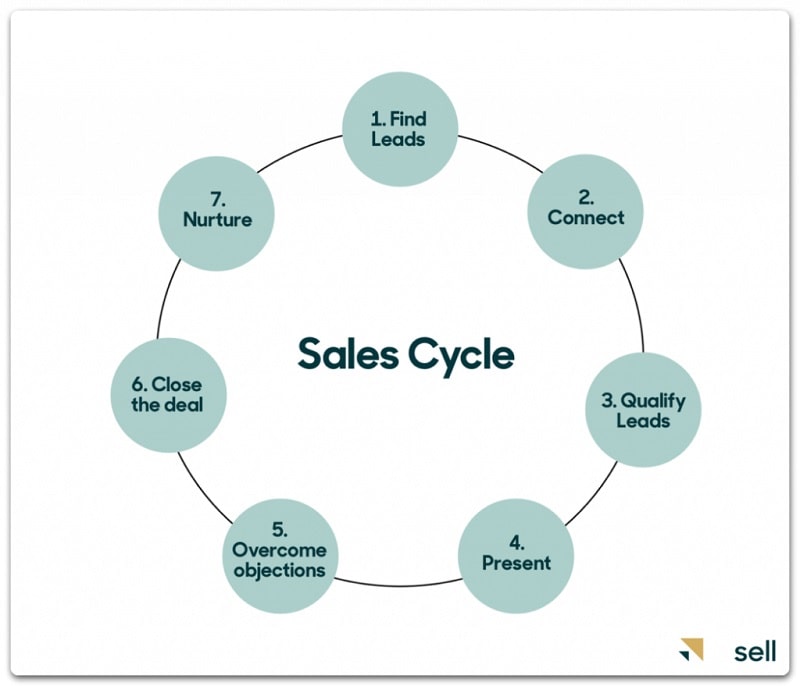
For example, the SaaS sales cycle is much longer than the Ecommerce sales cycle. There are many ways to shorten this cycle, of course, one of which is to personalize your selling. Here are some other tactics to consider:
- Create a powerful value proposition.
- Engage only with the decision-maker.
- Address concrete customer pain-points.
- Build social proof on your site and social media.
- Come prepared for every conversation.
- Make it easy to buy on any online or offline touchpoint.
- Use marketing psychology such as the FOMO (fear of missing out) approach.
Cost of customer acquisition
The next important metric that can define the future of your business, especially in a time of crisis, is the customer acquisition cost. Needless to say, your goal should be to minimize your CAC as much as possible, but it will never be lower than the cost of retaining loyal customers. CAC includes all expenses associated with converting a customer from the moment you establish contact.
You can establish contact using an outbound sales solution and strategy, such as selling a DM or cold-calling, or you can use inbound methods to inspire the customer to reach out. Both strategies have their merits, but inbound strategies such as content marketing are generally safer and will generate qualified leads. Remember, you have a much higher chance of converting a prospect if they are genuinely interested in what you’re selling.
How to calculate CAC
To calculate your CAC, compile your total sales and marketing expenses and divide by each new customer acquired in a specific period. This is your average CAC across the board. But if you want to go deeper and measure the CAC on each channel, simply use the channel-specific sales and marketing expenses divided by the number of new customers on that channel.

Overall customer support satisfaction
We might sound like a broken record by now, but here’s another metric that can impact the future of your business. We’re not trying to be dramatic; it’s just that it’s all so important, promise.
Your support staff is often tasked with light sales and marketing tasks – even if you might not realize it. You might think that they’re there to simply answer some questions, but when trained right, these experts can help you convert big time.
But in order to do that, you have to ensure the customer’s satisfaction with your support department. You need to know how satisfied people are with your support process because you want to know the potential for selling, upselling, and cross-selling.
For example, if you have a toll-free number that’s available 24/7, you can provide a high level of service that people will appreciate. That’s an immediate plus for you, but you can also improve their experience with a live chat function, quick email response times, and social media communication.
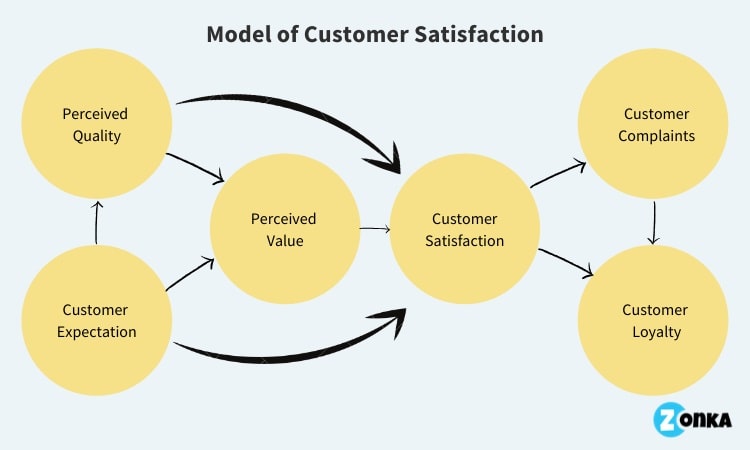
How to calculate support satisfaction
There are many ways to do it, and there isn’t a single formula. You can use end-of-session surveys, quick questionnaires, and exit rating systems to prompt the customer to leave a quick review or rate their experience. Put this in a specific timeframe to calculate the average satisfaction level, but make sure to take a closer look at the individual cases as well.
Customer retention rate
You heard it time and time again – it’s much cheaper to retain a customer than to acquire a new one. The customer retention rate is, therefore, the number of customers you retain in a specific timeframe. You can calculate this rate on an annual, quarterly, or monthly basis to gain meaningful insights into your retention strategy.
Repeat customers already know and trust your brand, and it takes less time, effort, and money to inspire them to buy again. This is why you should monitor your retention rate and strive to boost customer loyalty.
You can also steal some of these marketing tactics to boost repeat sales and new conversions.
Improving customer loyalty takes time, and you can do it by:
- Building social proof on all channels.
- Providing excellent customer service and guidance.
- Maintaining or improving the quality of your products or services.
- Gather customer feedback to optimize your communication, engagement, marketing, and more.
- Establish high-value loyalty programs for your cherished customers.
How to measure your retention rate
To measure your retention rate, you need to subtract the number of new customers from the total number of customers in a specific period. Then, divide the result by the number of customers at the beginning of that time period. After that, multiply by 100.
This is your retention rate, and here’s what that looks like when we visualize the process:
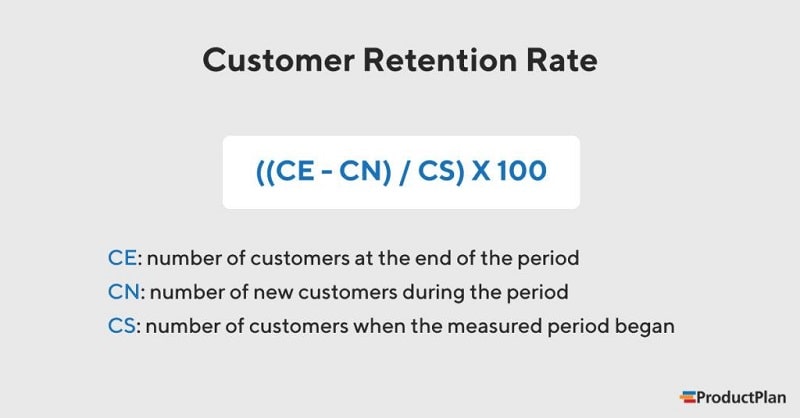
Annual burn rate
Your burn rate is the rate at which your company is “burning” through its budget. While it’s pretty easy to automatically create burn rate reports with a simple accounting tool and some analytics tools, it’s important to compare this rate with the crucial services and systems you’re using. For example, you should compare your burn rate with your hosting plan, as running an online business requires significant online resources.
You may also discover that your current plan is costing you more money than it’s worth and that you would earn more with dedicated WordPress hosting on an annual level. Use this mindset to compare your burn rate with similar systems and services you’re paying for. These include all cloud-based marketing and sales tools (like your CRM), CWPP, project management software, VoIP systems, and more.
How to calculate burn rate
You can calculate your burn rate by subtracting the total cash at the end of a period from the total sum at the start of the period. But modern software will do that for you and let you delve deep into the specific cash flow channels, financial risks and common problems your company is facing.

Customer churn rate
The customer churn rate shows you how many customers you’ve lost in a given time period. A low churn rate tells you that your customers are satisfied with your brand as a whole, believing that your products are solving specific problems.
However, the churn rate can look different between industries. If you’re in the eCommerce game trying to boost sales and minimize churn, you will need to look at the customers that failed to make a repeat purchase. However, if you’re in the SaaS industry, your churn rate is the number of customers that canceled their subscription. This means paying customers, not any free trials or promo campaigns.
How to calculate customer churn rate
To calculate your churn rate, divide the total number of customers churned in a time period by the total number of customers at the start of the period. Then multiply by 100 to get a percentage.
Here’s what that looks like:
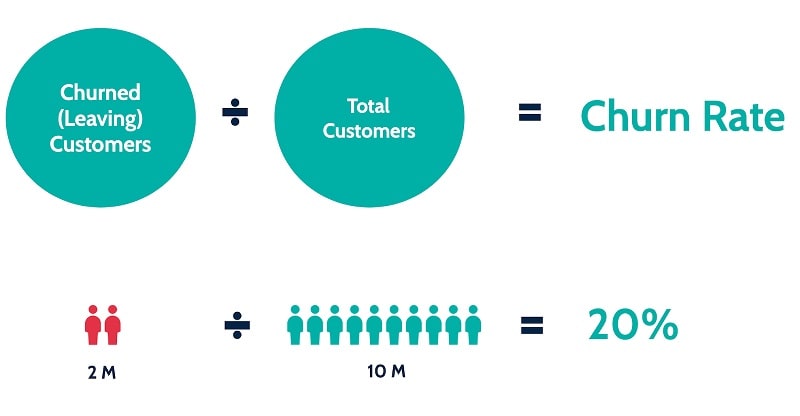
Customer lifetime value
Customer lifetime value (LTV) gives you an insight into the potential revenue a customer can bring in within a longer timeframe. We could be talking about months, but in reality, the LTV metric should estimate the value of a customer in years. Provided that you nurture your customers and keep adding value to your relationship, you should have no problem keeping them at your side.
To achieve all of this, you need to know the basics of starting an online business that go beyond picking a name and deal with more nuanced steps. These steps include defining your sales and marketing strategies, your unique value proposition, various inbound strategies, and more. This is how you can maximize the LTV of every new customer from the start.
Keep in mind that this metric is better suited to established businesses than new brands, though. This is because established companies typically have more long-term customers, allowing them to more accurately predict the LTV of a new customer. Speaking of new customers, here are some tips on how to build a high-converting landing page.
How to calculate your LTV
If you’re running a SaaS business, you’ll need to multiply the average monthly revenue per customer with the average customer lifetime (how long someone uses your software).
If you’re running an Ecommerce business, on the other hand, then multiply your average order value with repeat sales, and then multiply that with your average customer retention time. This is your average lifetime value.

Overall employee happiness
Last but not least, we would be remiss not to talk about employee happiness. Customer-facing metrics are important, but so are the metrics that tell you how satisfied your employees are with your brand. After all, happiness in the workplace is a precursor to productivity, higher commitment, and loyalty.
Keep in mind that your priority right now should be to retain talent, not look for new employees in a time of crisis. What’s more, happy employees will be your biggest brand advocates and will win over more customers for you – it’s kind of a win-win scenario.
How to measure employee happiness
There is no formula here, you simply need to care about your employees enough to ask if they’re happy. You can use an HR tool to collect feedback quickly, but you can also use surveys and questionnaires. Consider one-on-one meetings as well to gain more detailed insights and inspire the individual to give more honest answers.
Remember, people need to feel safe and at ease in order to tell you what they really think.
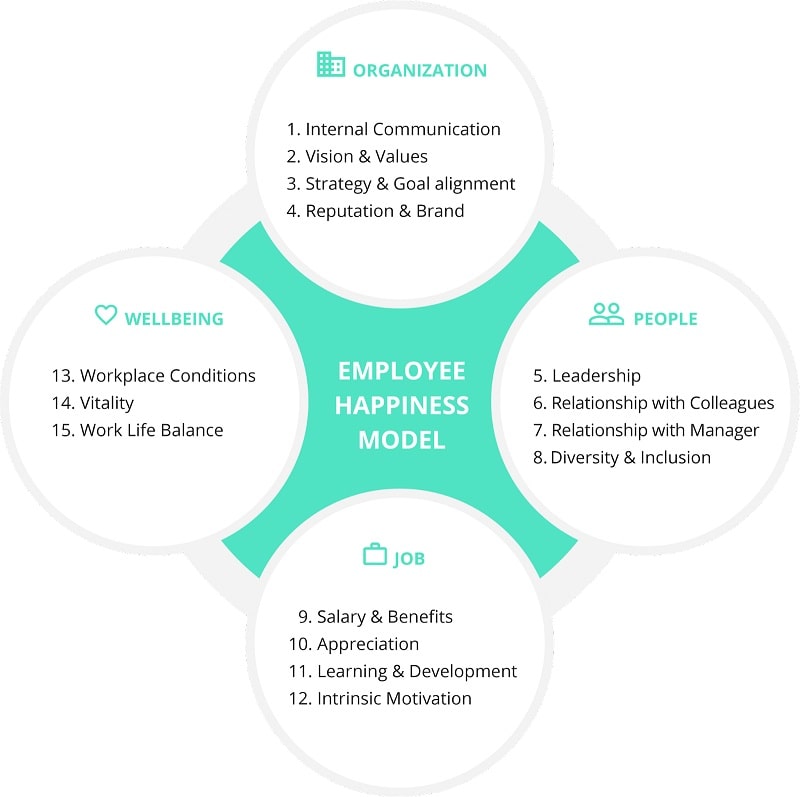
Source
Related Content
- 5 Metrics You Must Track For Social Media Lead Generation
- Data-Driven Marketing: The KPI’s We Use to Judge Success and Failure
- 8 Email Marketing KPIs Every Campaign Should Use for Success in 2021
- How to Measure AdWord ROI and KPI’s for Your Small Business
- How to Use Analytics to Increase Your Content Marketing ROI
Wrapping up
In the end, there is no denying that your success will depend on how well you collect and manage key data and insights. When you’re running a small business online or offline, you need to consider the growth metrics and KPIs that matter:
- Average sales cycle length.
- Cost of customer acquisition.
- Overall customer support satisfaction.
- Customer loyalty and retention.
- Overall burn rate.
- Customer churn rate.
- Customer lifetime value.
- Employee happiness and productivity.
Focus on these vital metrics, and you should have no problem taking your business forward in 2022 and beyond.

Written by our guest writer Artem Minaev.
Co-founder of FirstSiteGuide. Entrepreneur and online business supporter. Helping people to start, build, and grow online businesses.



